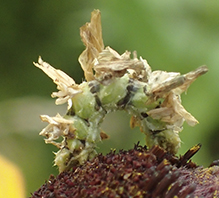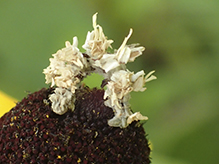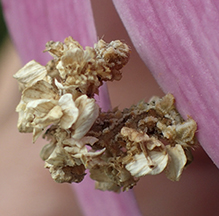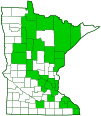wavy-lined emerald
(Synchlora aerata)
Conservation • Description • Habitat • Ecology • Distribution • Taxonomy
|
||||||||
| Hodges # | 7058 |
|||||||
Conservation Status |
||||||||
| IUCN Red List | not listed |
|||||||
| NatureServe | N5 - Secure SNR - Unranked |
|||||||
| Minnesota | not listed |
|||||||
Description |
||
Wavy-lined emerald is a small, common, widespread, geometer moth. It occurs throughout the United States, Mexico, and southern Canada. The larvae feed on a wide variety of plants but especially plants in the aster (Asteraceae) family. Adults are found from late June through August in open areas with forbs, including prairies, meadows, old fields, and disturbed areas. They are also found in shrublands and open woodlands, but rarely in closed canopy forests with a sparse forb layer. Adults have a ½″ to 15⁄16″ (13 to 24 mm) wingspan. That is relatively large for an emerald moth (subfamily Geometrinae) but relatively small for a geometer moth (family Geometridae). Size is often given in terms of forewing length. The forewing length of females is 5⁄16″ to ½″ (8.5 to 12.0 mm), with a mean length of 7⁄16″ (10.51 mm). The forewing length of males is ¼″ to 7⁄16″ (7.0 to 10.5 mm), with a mean length of 5⁄16″ (8.67 mm). The antennae on the male are broadly feather-like with branches along both sides of the shaft (bipectinate) on the basal two-thirds. The extensions taper abruptly beyond the middle and the terminal one-third of the antennae are slender and unbranched. On the female the antennae are slender and unbranched. The wings are relatively large for the body size. They are rounded, never pointed or angled. They are pale green with a bright pigment that never fades and with no red or brown markings. The antemedial (AM) and postmedial (PM) lines are white and narrow. They are straight or only slightly wavy or toothed. On some individuals, the subterminal (ST) line is visible as a white dot at the end of each vein. The subcosta (Sc) and radius (R) veins are fused for only a short distance. The hindwings are the same color and have the same lines as the forewing. Some individuals have a slight outward bulge on the PM line between veins M3 and Cu2. The abdomen is the same color as the wings, and it has a white longitudinal line down the middle (middorsal). The caterpillar is small, no more than ⅝″ (1.5 cm) long. The body is brown, black, and white. There is a white oblique line on both sides of each abdominal segment that runs through the breathing pore (spiracle). Each segment of the thorax and abdomen has two elongated protuberances on the upper side, one near each side (subdorsal). The protuberances on abdominal segments 1 through 5 are especially long. Each protuberance has a stiff hair (seta) at the end and numerous much smaller spines. The caterpillar camouflages itself by attaching to the protuberances bits of the plants that it feeds on. With its small size it is best found by scanning Asteraceae flowers for anomalous plant fragments. |
||
Size |
||
Wingspan: ½″ to 15⁄16″ (13 to 24 mm) |
||
Similar Species |
||
Habitat |
||
Open areas with forbs, including prairies, meadows, old fields, and disturbed areas. Also shrublands and open woodlands. |
||
Ecology |
||
Season |
||
One generation per year from late June to August in the cool season zone, which includes Minnesota. Two or more generations per year in the transition zone and warm season zone. |
||
Behavior |
||
Adults are active at night and will come to lights. They rest with their wings spread out and flat. |
||
Life Cycle |
||
Partially grown larvae overwinter |
||
Larva Hosts |
||
A wide variety of plants but especially plants in the aster (Asteraceae) family. |
||
Adult Food |
||
Flower nectar |
||
Distribution |
||||
|
Sources 4, 21, 27, 29, 30, 75, 82, 83. The Moths of America North of Mexico Fascicle 18.1. Geometroidea, Geometridae (Part), Geometrinae Douglas C. Ferguson . 1985. The Wedge Entomological Research Foundation. |
|||
| 8/2/2023 | ||||
Occurrence |
||||
Common |
||||
Taxonomy |
|||
Order |
Lepidoptera (Butterflies and Moths) | ||
Superfamily |
Geometroidea (Geometrid and Swallowtail Moths) | ||
Family |
Geometridae (Geometer Moths) | ||
Subfamily |
Geometrinae (emerald moths) | ||
Tribe |
Synchlorini | ||
Genus |
Synchlora | ||
Synchlora is a large genus of small moths. There are 42 Synchlora species worldwide, 12 species in North America north of Mexico, and just 1 species in Minnesota. |
|||
Subordinate Taxa |
|||
wavy-lined emerald (Synchlora aerata aerata) wavy-lined emerald (Synchlora aerata albolineata) wavy-lined emerald (Synchlora aerata liquoraria) |
|||
Synonyms |
|||
Aplodes glaucaria Aplodes rubivora Eunemoria gracilaria Eunemoria tricoloraria Geometra mimicata Phalaena aerata Synchlora albolinearia Synchlora albolineata Synchlora liquoraria Synchlora rubivoraria Synchlora rubrifrontaria |
|||
Common Names |
|||
camouflaged looper (caterpillar) wavy-lined emerald wavy-lined emerald moth (adult) |
|||
Glossary
Antemedial (AM) line
A thin line separating the basal area and the median area of the forewing of Lepidoptera.
Postmedial (PM) line
A thin line separating the median area and the postmedial area of the forewing of Lepidoptera.
Seta
A stiff, hair-like process on the outer surface of an organism. In Lepidoptera: A usually rigid bristle- or hair-like outgrowth used to sense touch. In mosses: The stalk supporting a spore-bearing capsule and supplying it with nutrients. Plural: setae. Adjective: setose.
Spiracle
A small opening on the surface of an insect or arachnid through which it breathes.
Visitor Photos |
|||||
Share your photo of this insect. |
|||||
| This button not working for you? Simply email us at info@MinnesotaSeasons.com. Attach one or more photos and, if you like, a caption. |
|||||
Babette Kis |
|||||
Synchlora aerata wavy-lined emerald moth Synchlora aerata, wavy-lined emerald moth caterpillars are fairly common in fields, weedy areas, and in my case, tallgrass prairie remnants. The caterpillars disguise themselves by gluing parts of flowers onto their bodies. They're tiny, under half an inch, and often overlooked, because they look like dead parts of a flower. Adults I've found seem to like hedgerows, or shrubby areas near the prairie. |
|||||
wavy-lined emerald caterpillar on black-eyed Susan July 11 2021 |
 |
||||
wavy-lined emerald caterpillar on sweet black-eyed Susan, July 11 2021 |
 |
||||
Synchlora aerata caterpillar on purple coneflower |
 |
||||
MinnesotaSeasons.com Photos |
|||||
|
|||||

Slideshows |
||

Visitor Videos |
|||
Share your video of this insect. |
|||
| This button not working for you? Simply email us at info@MinnesotaSeasons.com. Attach a video, a YouTube link, or a cloud storage link. |
|||
Other Videos |
|||
| Synchlora aerata JackSon2 |
|||
About
Jul 25, 2014 |
|||
| Wavy-lined Emerald (Synchlora aerata) - It's Hard to be Invisible Nature's Wild Things |
|||
About
Mar 24, 2017 Wavy-lined Emerald (Synchlora aerata) (Camouflaged Looper) |
|||
| Synchlora aerata - Camouflaged Looper feeding on Joe-Pye Weed Stan Malcolm |
|||
About
Aug 15, 2010 Cohen Property, Colchester, CT, 8-15-2010 |
|||
| synchlora aerata on mentha x piperita Melody |
|||
About
Jul 25, 2017 Camouflaged Looper caterpillars foraging on peppermint flowers. |
|||


Created: 8/2/2023
Last Updated:


